Features
Terror, Wonder … Triumph!
4 marine scientists make history racing across the Atlantic in a rowboat
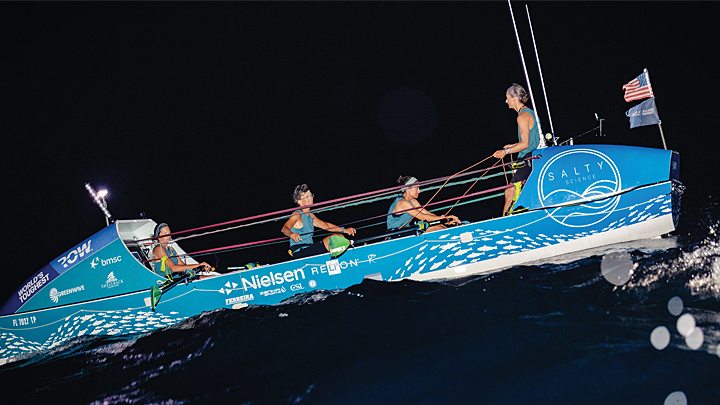
The Salty Science team aboard their boat, Emma, rowed 3,000 miles across the Atlantic Ocean in the World’s Toughest Row-Atlantic contest. [Photo: ©World’s Toughest Row-Atlantic]
By Daphne Kotschessa Almodovar / University Communications & Marketing
The night was moonless, pitch-dark. Massive waves crashed onto the deck of the 28-foot rowboat, Emma, tossing it like a toy in the vast expanse of the Atlantic Ocean between Europe and North America. Alone below in a tiny cabin, Isabelle Côté covered her eyes and tried to claim her allotted two to three hours of sleep.
“I don’t want to be here. I don’t want to be here,” she thought.
“I had no idea what I was going to find when I opened the door of the cabin,” she later recalled. “Would my teammates still be on deck? I was terrified.”
While she lay curled in the cabin, her teammates — Chantale Bégin, Lauren Shea and Noelle Helder — fought towering wave crests and deep troughs.
“I don’t even know how to describe the feeling of staring down a 25-plus-foot wall of water from the deck of our boat,” says Shea. “All you can do is sit there and hope desperately that this won’t be the one that breaks directly on top of you.”
Days before, on Dec. 13, 2023, the women had boarded Emma and pushed off from Spain’s Canary Islands for a 3,000-mile race across the ocean — the World’s Toughest Row-Atlantic. After 38 days, 18 hours and 56 minutes, they finished first in the Women’s Class on Jan. 20 — the first North American team to ever win the category. They came in seventh overall out of 38 teams.
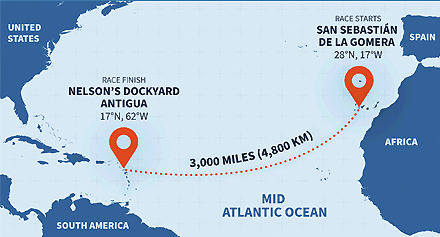
[Map: ©World’s Toughest Row-Atlantic]
During their time at sea, they would celebrate birthdays, Christmas and the New Year with dehydrated meals. They would row for 12 hours a day; try to sleep on sodden mattresses in stifling heat; endure seasickness, rashes and swollen limbs. They would experience terror — and wonder.
The course for the four friends, marine scientists aged 27 to 60, had been set eight years earlier at the University of South Florida.
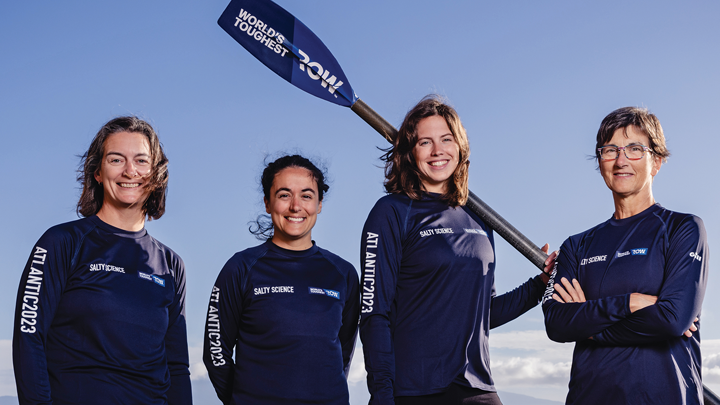
Salty Science, from left, Chantale Bégin, Lauren Shea, Noelle Helder and Isabelle Côté, pose in the weeks before their intercontinental row. [Photo: ©World’s Toughest Row-Atlantic]
In 2015, Shea and Helder, then marine biology undergraduates at USF, took a field course in the Caribbean led by Bégin, a USF professor. The two students stood out among their cohort and Bégin asked them to join her as field assistants. With shared interests, pastimes and values, the trio quickly bonded.
Shea graduated in 2017 and was working in Antigua when she happened upon a spectacle: The winners of the 2020 Atlantic race, an all-male team, were rowing across the finish line into Nelson’s Dockyard English Harbour.
An athlete who’d spent a lot of time on the water, she was immediately intrigued. She witnessed the finish again in 2021, this time on her 25th birthday, and knew it was something she wanted to try.
She also knew who might join her.
Within a day, Bégin, 42 at the time, and Helder, a 25-year-old 2016 grad, said, “Yeah! Let’s do this thing!”
They wanted a fourth teammate, and Bégin reached out to Côté, then 58, her doctoral advisor at Simon Fraser University in Canada. The three generations dubbed themselves Salty Science, a nod to their sometimes unabashed personalities and their commitment to marine conservation.
While the women were competitive runners and swimmers, none knew how to row in the ocean. They embarked on three years of preparation, including 18 months of intensive physical training entailing 10 to 14 hours a week working out and rowing in the Gulf of Mexico with a coach. They did it all while juggling full-time jobs, families and work toward advanced degrees.
They never dreamed of winning the race. They were novice rowers! They aimed to cross safely with their friendship intact, and row as fast as they could. They also hoped to raise awareness and $500,000 for ocean conservation. They had “Rowing Across an Ocean for the Oceans” emblazoned on Emma’s hull.
They would learn that this race is less about being an elite rower and more about being creative and resilient when problems arise, understanding how to navigate while leveraging winds and currents, and relying on one another’s strengths. In those areas, they’d had plenty of practice.
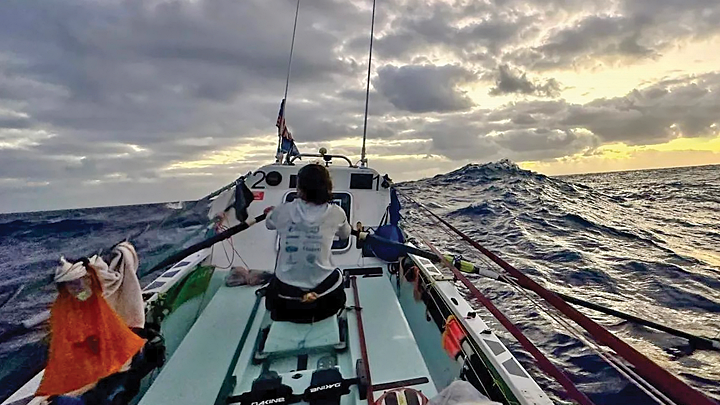
From Dec. 13, 2023 to Jan. 20, the four women rowed steadily across the Atlantic. [Photo: Courtesy Salty Science team]
The World’s Toughest Row tests competitors physically, mentally, emotionally and technically, says CEO and race director Carsten Heron Olsen. It requires rowing for hours in cramped quarters with little sleep while assessing weather conditions and making critical navigational decisions.
Those challenges were compounded in the 2023-24 race when teams rowed straight into ferocious conditions whipped up by a mix of low pressure systems and strong head winds, he says. Some of the boats ground to a standstill. Many were pushed off course and their crews had to fight their way back to a route that would ensure arrival in the West Indies island of Antigua.
Côté had no offshore experience. Training in the Gulf of Mexico, a pond compared to the open Atlantic, did not prepare her for the size of the waves that Salty Science encountered in the first 10 days.
“At least during the day, you could see what was coming for you,” says Shea. “When nighttime came around, you lost any ability to see beyond the end of your oars.”
Turning back was not an option.
“You can’t make it back because of the dominant winds and currents, and there’s no safety boat shadowing you. There’s no helicopter that can reach you by the time you are a few hundred miles offshore,” says Bégin.
And Emma had no engine.
But after every terror-filled night in those early days, the sun inevitably rose. The four women celebrated by sipping coffee on deck and listening to music. Restored, they could face another day.
They were rewarded with amazing sights, from seabirds thousands of miles offshore to whales, dolphins, tuna schools so dense they couldn’t avoid occasionally hitting a fish with an oar, and sharks, including one that rammed the rudder.
“I was the first to get hit by a flying fish jumping on deck — and it hit me right in the face, which hurt a bit more than I was expecting,” says Helder. “They are like little missiles!”
They also came to realize that stalwart little Emma wasn’t going to let them down.
“Once I started trusting the boat, I think that allayed a lot of fears,” Côté says. “Because, boy, she did not want to capsize.”
The equipment, though, was another matter. Oars split and oarlocks bent. The women struggled to fashion repairs amidst high seas.
“When the watermaker broke, I went into the cabin, and I cried,” Shea admits. “And then I reemerged, and I said, ‘OK, I had my breakdown. Now I’m gonna think about how to fix it.’”
Shea switched out the pump and rebuilt the electronics with satellite phone guidance from a technician.
Back at home, spouses, partners, children and friends cheered them on.
Bégin’s husband, Brendon “Boomer” Baumeister, is the assistant marine superintendent at the Florida Institute of Oceanography, located at USF St. Petersburg. He texted daily weather reports that helped the team chart courses to take advantage of favorable winds and currents. He proudly shared their progress on social media.
“Salty Science is absolutely crushing it,” he posted Jan. 13. “They are currently in 1st place women’s. We are pretty sure a North American women’s team has never won this race.”
Olsen attributes Salty Science’s historic win to the team’s individual and group strengths.
“They are outwardly tight-knit, consistent with their goals and aims, which of course aligns with the fact the team consists of three generations of STEM women,” he says. “They have spent a lot of time together in relatively stressful situations before.”
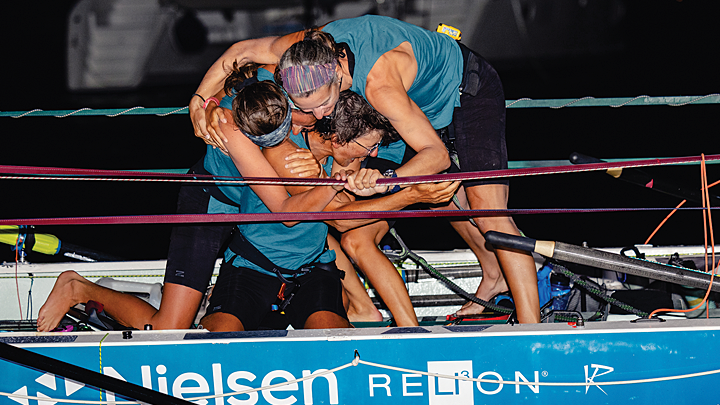
Salty Science shares an emotional embrace at the end of their 38-day row. [Photo: ©World’s Toughest Row-Atlantic]
All of a sudden we’re the first women’s team and it’s like, whoa, how did that happen?” says Shea.
“I think that, as we’ve kind of taken a step back and reflected on all that we did to get there, it also maybe isn’t that surprising. … Our preparation for the trip and our intentions going into the trip and throughout the trip of remaining friends and supporting each other, that’s why we won.”
Getting off the boat was challenging.
“For two days I could not walk unaided,” says Côté.
The hours spent gripping oars left them struggling, for a time, to open jars or hold a pencil in their calloused, clawed hands. And despite gobs of sunscreen and high-tech UV clothing, all suffered overexposure from the blazing sun.
It’s all worth the effort, they say. While they’re still working hard to achieve their goal of raising $500,000 for educating the next generation of marine scientists, at presstime, they were more than halfway there. The money will be divided evenly among the nonprofit Bamfield Marine Sciences Centre in British Columbia; Green Wave, a Connecticut nonprofit; and Shellback Expeditions, a nonprofit co-founded by Bégin and dedicated to involving young marine scientists with conservation projects in the Eastern Caribbean.
Olsen says Salty Science’s influence will be seen for years to come. A documentary about the team is in production and the BMSC Salty Science Scholarship is being established at the Bamfield Centre.
As for Emma, she’s already got her next adventure lined up. She’s been sold to a team planning to row from California to Hawaii — the World’s Toughest Row-Pacific.
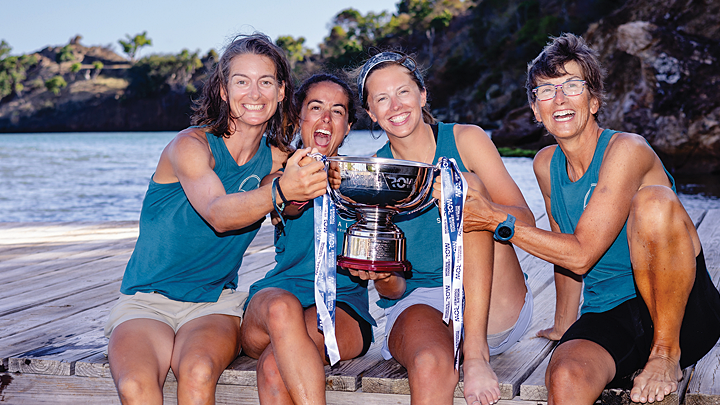
From left, Bégin, Shea, Helder and Côté show off their championship trophy. They were the first-place women’s team in the 2023 World’s Toughest Row-Atlantic. [Photo: ©World’s Toughest Row-Atlantic]
WHERE THEY ARE NOW
Bégin continues to teach multiple courses, including an annual service-learning field course in the Caribbean, in USF’s Bachelor of Science marine biology program.
Shea is completing her master’s degree at the University of British Columbia, where she is conducting research in global fisheries economics.
Helder is a marine ecologist and geospatial scientist with the University of Alaska Fairbanks.
Côté is a professor of marine ecology at Simon Fraser University in British Columbia. She has partnered with Bamfield Marine Science Centre in Canada to create the Salty Science Scholarship fund, designed to make marine science education more accessible to diverse students.